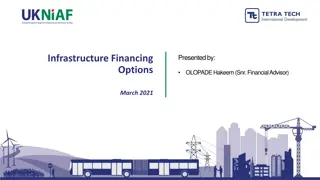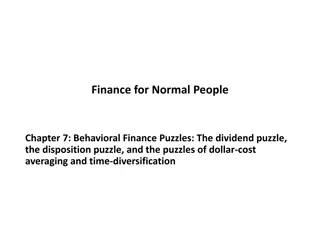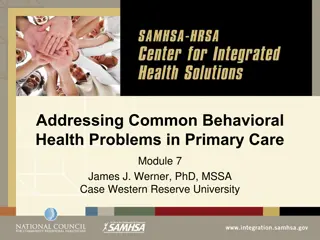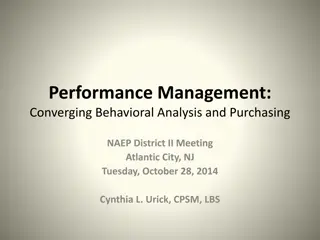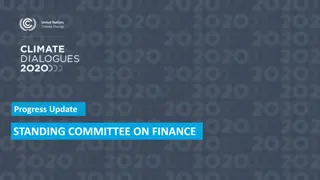Understanding Behavioral Finance and Technical Analysis
Behavioral finance explores irrational behaviors in decision-making processes in finance, highlighting the limitations of rationality assumptions. It delves into information processing problems and behavioral biases that can distort market prices. The consistency between technical analysis and behavioral finance is explored to provide a theoretical foundation for market anomalies. Investors' affect, risk, and return preferences are also key focuses in behavioral finance.
Uploaded on Sep 26, 2024 | 0 Views
Download Presentation

Please find below an Image/Link to download the presentation.
The content on the website is provided AS IS for your information and personal use only. It may not be sold, licensed, or shared on other websites without obtaining consent from the author. Download presentation by click this link. If you encounter any issues during the download, it is possible that the publisher has removed the file from their server.
E N D
Presentation Transcript
CHAPTER 9 Behavioral Finance and Technical Analysis
Learning Goals of Chapter 9 Introduce important findings in behavioral finance ( ) Behavioral finance, a relatively new field in finance, is proposed to explain some anomalies ( ) Discuss the consistence between the technical analysis and behavioral finance Behavioral finance can provide the theoretical foundation to explain why the technical analysis sometimes works even in an efficient market Introduce several classic technical analysis methods ( ) There is a lot of descriptive content in Ch. 9, so I rearrange the lecture slides in a more logical and succinct way 9-2
Behavioral Finance Proponents of EMH believe that competition among many professional (rational) investors ensures that security prices ought to be correct They take advantage of distorted prices, thus driving prices back to their proper levels Existence of irrational investors is not sufficient to render capital markets inefficient Premise of behavioral finance: actions of arbitrageurs are limited ( ) and insufficient to force prices to their intrinsic values Price distortions or anomalies may exist, e.g., in 1990s, the overall P/E ratios ( ) are too high than the theoretical estimation in the U.S. 9-4
Behavioral Finance Behavioral finance explores irrational behaviors ( ) on decision making to interpret the anomalies ( ) or the distortion Irrational behaviors are common for humans, and some are already discovered in psychology but not consistent with the assumptions of human behavior in Economics and Finance In addition to risk and return, behavior finance focuses as well on affect, which is a good or bad feeling attached to investment decisions Investors favor stocks with good affect (e.g., firms with reputations for social responsibility or attractive working conditions) and drive up (down) their prices (rates of return) 9-5
Behavioral Finance Irrationalities fall into two categories: Information Processing Problems ( ): Investors do not always process information correctly, e.g., infer ( ) incorrect probability distributions about future rates of return Behavioral Biases ( ): Investors often make inconsistent or suboptimal decisions 9-6
Information Processing Problems Forecasting errors ( ) Limited attention ( ): humans make decisions based on the limited knowledge they can gather People have weight recent experience too much ( ) (also known as memory bias) Thus, people extrapolate ( ) trends too far into the future or make too extreme forecasts De Bondt and Thaler (1990) employ forecasting errors to explain the P/E ratio effect: Recent good (poor) performance investors tend to forecast the firm s future profitability too high (low) stock price and P/E becomes relatively high (low), so high (low) P/E stocks tend to perform poor (well) when investors recognize and correct their errors The above inference also can explain the reversal effect for recent extremely performing stocks 9-7
Information Processing Problems Overconfidence ( ) People tend to overestimate the precision of their beliefs or forecasts, i.e., they tend to overestimate their abilities to predict future returns For overconfident investors Trading volume may be relatively high ( ) Turnover rate is high ( ) Such overconfidence may be responsible for the overly frequent trading and the widely adopted active management for mutual funds It is well-known that adopting the active management in efficient markets is mostly wasted However, it is difficult to become a fund manager, and once people become fund managers, it is possible that they are too confident of their investment abilities 9-8
Information Processing Problems Conservatism ( ) A conservatism bias means that investors are too slow (or said too conservative) in updating their beliefs in response to new evidence Or called anchoring bias ( ) since people become anchored to their ideas and will not update their expectations when new information arrives This underreaction to news leads to momentum effect ( ) in stock returns Investors may underreact to news, so market prices, determined by the consensus belief of investors, reflect news gradually 9-9
Information Processing Problems Representativeness bias ( ) People are too prone to believe that a small sample is representative of a population ( ) and thus infer patterns too quickly based on small samples ( ) Also called the sample size neglect bias ( ) because people often neglect that the sample size is too small to derive reliable forecasts Gambler s fallacy ( ) To flip a coin, the previous ten results are all heads Since the numbers of heads and tails should be very close in the long run, the gambler concludes that it is with higher probability to have tail results for the following games In fact, for each flip, the probabilities of head and tail are both 50% regardless of prior results The forecasting errors (memory bias) can be regarded as a type of representativeness bias 9-10
Behavioral Biases Framing effect ( ) Decisions are affected by how choices are posed ( ) Ex1. 600 patients, 4 treatments 0 live, with prob = 2/3 (1) A: 200 live B: 600 live, with prob = 1/3 600 die, with prob = 2/3 0 die, with prob = 1/3 (2) C: 400 die D: Patients prefer treatment A to treatment B, and prefer treatment D to treatment C However, treatment A is equivalent to treatment C, and treatment B is equivalent to treatment D Ex2. Gains (losses) relative to lower (higher) baseline level could be amplified illusively 9-11
Behavioral Biases Mental accounting ( ) Individuals segregate decisions into different accounts For example, people with insurance policies (conservative account) also buy lotteries (risk-taking account) Statman (1997) employs the mental accounting to explain the irrationality that some investors would like to spend cash dividends but refuse to sell stock dividends for consumption Treat cash dividend (like salary) in the income account, but treat stock dividend (like asset) in the wealth account Use capital gains account vs. initial investment account to explain the momentum effect: capital gains account is more tolerant of risk, discounts cash flows at a lower rate, and thus further pushes prices up 9-12
Behavioral Biases Regret avoidance ( ) and Disposition effect ( ) Regret is a post-decision feeling of pain regarding not having chosen a better alternative and people tend to avoid regret ( ( ) ) Disposition effect: investors try to avoid regret by realizing capital-gain stocks too early and keeping capital-loss stocks too long For a capital-gain stock, investors are afraid that once the price falls, they cannot sell shares at such high level realize the capital-gain stock too early to avoid regret For a capital-loss stock, investors are afraid that the price moves reversely and goes upward after they sell shares selling the capital-loss stock too late to avoid regret 9-13
Behavioral Biases Prospect theory ( ) Proposed by Kahneman and Tversky (1979), and Kahneman is the Nobel Prize winner in 2002 The most important theory in behavioral finance They design some psychological experiments to examine how people make decisions when they face different kinds of gambles 1. The results show that what affects people's decisions is not their wealth level after the gamble, but the amount of gains or losses from the gamble 2. Loss averse attitude: people are more sensitive about the losses than the gains The decrease of the utility ( ) from $1 loss is larger than the increase of the utility from $1 gain 9-14
Behavioral Biases 3. People will become more willing to take risks to avoid losses (individuals are risk averse when facing gains but become risk loving when facing losses) $4000, with prob = 0.8 $0, with prob = 0.2 For gains: $3000 $4000, with prob = 0.8 $0, with prob = 0.2 For losses: $3000 Risk aversion for gains and risk loving for losses can explain the disposition effect Prospect utility reflects the above three findings ( ) if ( ) ( ) if where is the change of wealth, is the risk averse coefficient, and 1 is the loss averse coefficient 1 A 0 0 w w w = , u w 1 A w w A 9-15
Prospect Theory In traditional economics, people are assumed to be risk averse and with a concave utility function (in Diagram A) In Prospect Theory, people are risk averse (thus with concave utility function) when facing gains and risk loving (thus with convex utility function) when facing losses (in Diagram B) 9-16
Limits to Arbitrage Fundamental risk The distortion could get worse or maintain for a long enough horizon such that the exploitation of that distortion to profit is limited (e.g., a trader may run out of his capital or a fund manager may lose his job before the prices go back to the fair level) Implementation difficulties The short sell constraint for mutual fund managers Or short-sellers may have to return the borrowed securities soon after the notification from the broker, that makes the horizon of the short sale uncertain Model risk One worries about that an apparent profit opportunity is due to using a faulty model to value the security 9-17
Examples for Violation of Law of One Price Siamese twin ( ) companies In 1907, Royal Dutch Petroleum (RDP) and Shell Transport (ST) merged their operations into one firm RDP receives 60% cash income, and ST receives 40% cash income, so it can be expected that the price of a RDP share is 1.5 times as high as the price of a ST share (see the figure on the next slide) Closed-end funds Shares of closed-end funds are traded at substantial discounts or premiums from their net asset values Ross (2002) mathematically proves that if the abnormal return ( ) is larger (lower) than the expense ratio, the closed-end funds should be traded at a premium (discount) to NAV 9-18
Pricing of RDP Relative to ST (Deviation from Parity) Consistently positive deviation lasts more than 7 years The y-axis is the percentage deviation from the parity ratio of 1.5 This figure shows that the relative value of the two firms departed form this ratio for a long time (From Feb. 1993 to Mar. 2000, the ratio between the prices of RDP and ST is constantly higher than 1.5 for more than 7 years) 9-19
Bubbles () and Behavioral Economics From 1995 to 2001, the Nasdaq index increased by a factor of more than 6 This dot-com boom development could be explained by some irrationalities in behavioral finance In this period, investors were increasingly confident of their forecasts (overconfidence bias) and apparently extrapolate short-term patterns into the distant future (memory or representativeness bias) The overconfidence arises from the situation in which investors always earn huge capital gains regardless of what to buy and when to buy The interaction of these two biases can explain the bubble from 1995 to 2001 9-20
Critiques for Behavioral Finance Behavioral finance tries to explain anomalies but DOES NOT give guidance of how to exploit these irrationalities Behavioral finance explains each anomaly by some subjective combination of irrationalities from the list of behavioral biases. There is no unified behavioral theory to explain a range of anomalies It is possible to have conflicts between different theories, e.g., overreaction (from memory or representativeness bias) vs. underreaction (from conservatism bias) 9-21
9.2 TECHNICAL ANALYSIS AND BEHAVIORAL FINANCE 9-22
Technical Analysis and Behavioral Finance Consistence between the technical analysis and behavioral finance Technicians believe that prices only gradually go back to their fair values, and they can exploit the slow adjustments to make profit momentum effect and conservatism bias Behavioral biases are also consistent with technical analysts use of volume data to form trading strategy As traders become more overconfident, they may trade more, inducing an association between trading volume and market returns Technicians as well as some proponents of behavioral finance believe that market fundamentals could be affected by irrational or behavioral factors, sometimes labeled sentiment variables ( ) 9-23
Technical Analysis and Behavioral Finance In summary, the authors of this text book believe that The reason why the technical analysts can make profits is actually from exploiting irrationalities of investors rather than finding some useful information or patterns Behavioral finance, which is proposed to explain these irrationalities, may provide the theoretical foundation for the feasibility of technical analyses in financial markets 9-24
Some Technical Analysis Method Dow theory ( ) The ancestor of trend analyses or technical analyses, created by Charles Dow, who is a journalist, the founder and first editor of the Wall Street Journal, and co-founder of Dow Jones & Company Following Dow s death, Hamilton, Rhea, and Schaefer organized and collected Dow Theory, based on Dow s editorials about financial markets Six basic principles of the Dow theory 1. The market has three factors simultaneously affecting stock prices: primary trends, intermediate trends, and minor trends, see the figures on the next two slides 9-25
Dow Theory Trends Primary trend: long-term movements, continuing from months to years Intermediate trend: short-term deviations from the underlying primary trend, which could retrace from 33% to 66% of the primary movement Minor trend: daily fluctuations which are with little importance in the trend analysis of the Dow theory 9-26
Some Technical Analysis Method 2. A trend has three phases i. Accumulation phase: some foresighted investors are actively trading stock against the general opinion of the market ii. Rapid price change phase: the trend followers or other technically oriented investors catch on to these foresighted investors iii.Final phase: the second phase continues until rampant speculation occurs, and at this point, the foresighted investors begin to distribute their holdings to the market 3. The stock market reflects all news quickly: Dow agreed with the efficient market hypothesis in some degree 4. Stock market averages must confirm each other Dow believed that if manufacturer s profits are rising, more products should be shipped to customers The performance of shipping companies, which are mostly railroad companies in the Dow s era, should also rises The industrial average index and the transportation average index should move in the same direction in a real trend 9-27
Some Technical Analysis Method 5. Trends are confirmed by volume When price movements are accompanied by high volume, Dow believed this represented the true market view To him, it is a signal that a trend is developing 6. Trends exist until definitive signals ( ) prove that they have ended Dow believed that trends exist despite market noise However, determining whether a reversal is the start of a new trend or a temporary deviation in the current trend is very difficult When there are definitive signals to prove the existence of a trend, usually the trend is almost ended, i.e., the trends are always recognized after the fact 9-28
Some Technical Analysis Method Moving averages ( ) For each day, the moving average of a specified period of time, e.g., 4 weeks, is recomputed by dropping the oldest observation and adding the latest By definition, the long-term moving average is a more smooth series than the short-term moving average When the short-term moving average crosses the long-term moving average, a trading signal occurs Bullish (bearish) signals occur when the short-term moving average penetrates the long-term moving average from below (above) (In Taiwan, this bullish (bearish) signals are called ( )) This is because when the recent performance is significantly superior (inferior) to the past performance in a longer period, it is expected that this time point is the beginning of a rising (falling) trend 9-29
Share Price and 25-Day Moving Average for Apple Bearish signal Perfect selling point Bullish signal Perfect purchasing point The curve in black represents the daily share prices, which can be viewed as the shortest-term (1-day) moving average, and the line in brown represents the 25-day moving average In this case, both signals provide satisfied forecast about the future movement, although they cannot identify the perfect selling and purchasing time points 9-30
Some Technical Analysis Method Point and figure charts ( ) In a rising (falling) trend, whenever the stock price increases (decreases) by, for example, $2, mark an X (O) corresponding to the current stock price in the grid of the point and figure chart It traces significant upward or downward movements in stock prices regardless of their timing The aim of this chart is to filter out the noise (unimportant price movements) and focus on finding the main direction of the price trend Different from other technical analyses, this chart has no time dimension Log scaling point and figure charts: X s and O s are marked according to a percentage change, which allows the sensitivity of this method to remain constant for high and low stock price levels 9-31
Stock Price History and Point and Figure Chart Each column consists of only one letter (either X or O) never both New columns are placed to the right of the previous column and are only added once the price changes direction by more than a predefined minimal change amount 9-32
Point and Figure Chart for Atlantic Richfield Buying signal Selling signal An congestion area ( ) is a horizontal band created by several price reversals, i.e., consisting of alternate columns of X s and O s, and the upper and lower bounds for an congestion area correspond to the resistance and support levels ( ) When the stock price penetrates ( ) the resistance (support) level from below (above), it means the market consensus about the prospect of the stock is significantly better (worse) than that in the previous congestion area and thus a buy (sell) signal is generated 9-33
Some Technical Analysis Method Breadth ( ) The extent to which the trend of the broad market index is widely reflected in movements of individual stock prices Breadth is measured as the difference between the number of advancing stocks ( ) and declining stocks ( ) If the advances outnumber declines by a wide margin, then the stock market is viewed as being stronger because the upward rally is widespread (see the next slide) 9-34
Breadth The direction of the cumulated breadth series is used to discern stock market trends When the cumulative breadth increases (decreases), the market is viewed as being stronger (weaker) because the upward (downward) rally is more widespread Analysts might use a moving average of cumulative breadth to gauge ( ) stock market trends 9-35
Some Technical Analysis Method Relative strength ( ) Defined as the ratio of the price of an individual stock over the level of an industry index Also can be defined as stock vs. market or industry vs. market A rising (falling) ratio implies security has outperformed (underperfomed) the particular industry average and generates a signal to buy (sell) Make profit if the relative strength can persist over time Buy relatively strong and short relatively weak stocks in the same industry: The market and industry risks can be eliminated and earn purely the performance difference between the two stocks E.g., buy shares of TSMC and short shares of UMC 9-36
Machine Learning and Technical Analysis Machine learning Not commonly classified as a technical analysis However, if technical analysis is defined as using past patterns in prices (and other trading data) to forecast the future, machine learning is, at the very least, related Renaissance Technology (an American hedge fund) Its Medallion fund generated average annual before-free (after-fee) returns as high as 66% (39%) in 1988-2018 By heavily using computers, it searches for possibly slight price misalignments in unimaginable amounts of data and uncovers relations that are generally multidimensional and beyond the ability of a human to detect in real time Its pairs trading avoids outright bets on the direction of price movement Its strategies, designed to profit regardless of market performance, are referred to as market neutral strategies 9-37
Sentiment Indicators () TRIN ( ): Volume declining/Number declining Volume advancing/Number advancing Average volume for falling stocks Average volume for rising stocks = TRIN = TRIN is the short of TRading INdex The TRIN ratio above 1.0 are considered bearish ( ( )) because the declining stocks would have higher average volume than the advancing stocks, indicating net selling pressure Note carefully that since for every seller, there must be a buyer, the TRIN ratio above 1.0 also indicates that there is more buying activity in declining stocks than in rising stocks 9-38
Sentiment Indicators () Confidence index ( ) Ratio of the average yield on 10 top-rated corporate bonds (e.g., 4%) over the average yield on 10 intermediate-grade corporate bonds (e.g., 7%) This ratio is always smaller than 1 because higher rated bonds will offer lower promised yields to maturity The increase of this index indicates bullish ( ( )) signals in the stock market because when investors become optimistic about the future, they require small default premium and thus the yield spread is narrowed Additional assumption: actions of bond traders reveal trends that will emerge soon in the stock market 9-39
Sentiment Indicators () Put/call ratio ( ) Call options grant holders the right to buy at a fixed exercise price (often used when it is believed the market will rise) and a put option is the right to sell at a fixed exercise price (often used when it is believed the market will fall) The ratio of outstanding put options to outstanding call options is called the put/call ratio The increase of this ratio indicates bearish signals 9-40
Sentiment Indicators () Short interest ( ) Total number of shares that are sold short but not yet closed out When the short interest is high, a bearish signal occurs Furthermore, since short-sellers tend to be larger, more sophisticated investors, which often know something inside, the increase of this number indicates the bearish sentiment of those investors 9-41
A Warning Although we cannot deny the ability and effort of investors to discern apparent patterns in stock market prices, it is also possible to perceive patterns that may not exist (It is a major shortcoming for the technical analysis) The actual and randomly simulated stock prices are shown on the next slide 9-42
Actual and Simulated Levels for Stock Market Prices of 52 Weeks Upward primary trend from the Dow theory Selling signal based on the point and figure chart If you employ the technique analysis methods we learned in this chapter, maybe you can find some pattern in the right figure However, the right figure is constructed from totally RANDOM simulations Since there should be patternless for the movements in the right figure theoretically, how could it possible to identify any pattern in this figure? 9-43








